From my recent diary
2006
Tue Dec 26
As forecast predicted there are no cloud this predawn but transparency
was pretty poor as opposed to yesterday. I set up the scope and started
sweeping the sky at 4 a.m., however, it became extremely hazy in a
short time. At 4:10 a.m. Beta Corvi was deteriorated to naked eye
limited. I waited for 10 minutes but the sky became worse and I decided
to stop today's session.
Mon Dec 25
Wonderful sky! Though today last year snow depth was much
deeper than my stature, today there was no
snow at the summer observing site. Under excellent transparency I began
to comet hunt at Eta Corvi. The
movement of the telescope was very smooth.
I conducted vertical method as usual. I swung the scope downward from
an altitude of some 40 degrees and when it reached the horizon I shift
the field about 0.3 degrees northward (rotate the scope
counterclockwise); this value must be
varied depending on azimuth. Then, I quickly
raised up the telescope until 40 degrees in altitude without looking
through the eyepiece and repeated sweeping downward; due to a sidereal
motion and the northward shift the field is
overlapped by one third as a result.
Unexpectedly, I caught a lot of galaxies in the former half of today's
comet hunting session. The first galaxy I detected was M104. From here
to Spica, Alpha Virginis, I spotted 26 galaxies excluding M104. Many of
them were 12th magnitude or brighter and some were 13th. I wondered if
here are so many galaxies in this region. Dark and clear sky is
treasure for a comet hunter. At first I could enjoy identifying them,
however, it came to check a few galaxies in one field, I began to feed
up with catching galaxies.
The latter half of the session, the search area of the north of Spica,
I could observe only four galaxies: NGC5426, 5427, 5493 and 5634. Light
pollution and zodiacal light must reduce the number of observable
galaxies. I stopped comet searching at 6:00 a.m.; the biginning of the
towilight was late. It was winter solstice on December 22, and I could
afford to have 2 hours and 20 minutes comet hunting hours. This is one
of the longest comet hunting hours in one session.
Wed Dec 13
Again, I woke up at
ten past 2 a.m., though I set the alarm clock at 2: 40 a.m. I
also got up this time yesterday before the alarm rang but in vain: on Monday evening the forecast
said it would be clear on Tuesday predawn. Anyway, this is the first
comet hinting session this month!
This predawn it turned out that the sky was clear before I looked
at the sky through the window, since the moonlight shined into
the room from the opening between the curtains. I drove to the
observing site but usual site was inaccessible due to snow
accumulation. I headed for the winter site, it is a rather wide parking
space beside the road where snow is cleared away.
Everything was winter version except my mind. It was cold and I put on
a pair of gloves. Then, I began to assemble my 46 cm telescope. Ouch!
the rocker box of my Dobsonian slipped out from my hands because I put
on the gloves. Unfortunately, it hit my knee and I had to stood a
severe pain for a minute under the cold moonlight. I had been always
glove less when I carried the rocker box in wintertime. However, I
forgot about it since this is the first winter version session. My knee
slightly bled internally and the bottom edge of the rocker box was
damaged.
OK, the pivot was safe and I finished assembling the scope. After that
a cooling fan for a primary mirror and a dew remover stopped due to low
battery under the low temperature. This often happens in winter. I
changed it and at last started comet hunting.
The contrast in the field was low because of moonlight but it was
improved as the telescope getting away from the moon. At 5:00 a.m., a
quarter before the beginning of the twilight, thin cloud spread all
over the sky and a halo appeared around the moon. I finished the
session and enjoyed Sturan and Moon using BinoVue. Though I observed
them through cloud, they were still impressive! Contrary to the
previous comet hunting session, the only comet like object I caught was
M53.
Sun Nov 26
The forecast of last Sunday that predicted unfavorable weather did
not come true and there were three
fine days since then including today.
I got up at 2:20 am,10 minutes before the alarm clock rang, and drove
to the usual observing site. Wind was very strong at the site and I
moved to in the lee of the cliff where it took only two minutes drive
from my usual observing site. I could recognize counterglow just below
M45 in the same way as yesterday.
I began to comet search at 3:25 am but
scintillation was very bad; it was difficult even to distinguish a star
whose image was swelled by the strong wind from a small size galaxy.
I could not concentrate on the hunting and was irritated. However,
there was another reason that made me nervous.
Last night I
wondered if I should identify all the galaxies I would catch in the
coming predawn. At that time I decided to search the Coma Berenices and
Virgo region where there are so many galaxies. In Saturday predawn I
detected 41 galaxies mainly in Virgo and I have got bored. What is the
right
way of comet hunting in this region?
Tsutomu Seki's book reads that he recommends to search this region but
it is almost impossible to identify all the galaxies we catch. In
stead, we have to pay attention to "abnormal image" he said. Galaxies
in the region are darker than 9th magnitude and if a brighter object is
there it must be a new comet. Another point is that many comets have
diffused image that is deferent from that of galaxies. All we can do is
to check these unusual images, he said.
This is the first time I dared to sweep this region under excellent
transparency using 46 cm comet seeker and I did not know how many
galaxies I would
catch; that must be huge number.
As a result when I
began to
comet hunt I made up my mind to identify all the galaxies. Because I am
a comet hunter not a deep sky observer. What if there is a new comet of
13th magnitude? On top of this, I have to consider that the time has
changed; when Seki's book had published the digital setting circles
were not available nor excellent star charts. Now that these modern
tools are in my hand, it is much easier to identify many galaxies in a
short time.
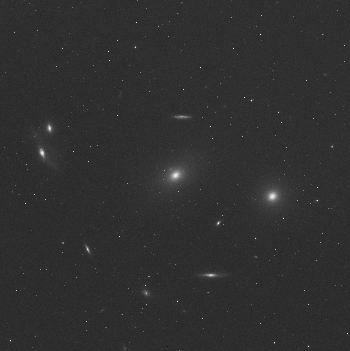
Near M86
I could detected 6 galaxies in this image. 1 degree square.
The Digitized Sky Survey copyright © 1994
Even so, actually it is a hard work to identify them all. Identifying a
single galaxy is easy. I can do it with the digital setting
circles using "search mode". However, I need to utilize both the
electric gadget and the
Uranometria 2000 when it comes to I catches several galaxies in the
same
field. I know Right Ascension and Right Declination but
quite a few of galaxies, much darker than I can observe, are printed
at the position! I have to rotate the chart and compare the field and
the chart.
As result, I could identify 68 galaxies, some of which were 13th
magnitude, and 3 globular clusters (M53, NGC5053 and M5). Scintillation
became much better before I knew it and I found myself enjoying various
forms of
galaxies.
After completed the hard work, I felt something satisfactory.
Oh, Mercury rose
above the horizon. Wonderful dawn!
Sun Nov 19
This predawn temperature was 1 degree Celsius and frost was formed for
the first time this fall. My motion was slower than that of a week ago
and it took a bit longer to assemble my 46 cm telescope because
of thick winter clothes and arctic boots.
In spite of rather poor transparency and partial thin cloud, I caught
half a dozen of galaxies in Hydra, most of them were 11 th
magnitude. After 4:30am the amount of cloud increased and covered most
part of eastern sky but I continued comet hunting through thin cloud or
among cloud gaps.
When I was about to finish this predawn's comet hunting session at
around 5:20 am, I observed very bright satellite, zero magnitude, fly
near Denebola, Beta Leonis; that turned out to be The International
Space Station (ISS) after I got home. In the lower south-east, waning
crescent moon with earthlight was impressive.
Winter is just around the corner; according to the outlook for the
coming week, nasty weather will
last.

A curve with a red arrow is the course of ISS, around 5:20 am, Nov 19,
2006 at my observing site.
Chart: The Heavens Above
http://www.heavens-above.com/
Sat Nov 4
There were so many fine days last month that I could comet hunt 14
times. This is a new record on a monthly basis.
This predawn the gibbous moon was in the sky till 4:15 am; half
hour before the beginning of the twilight. Though I
could comet hunt one hour, the clarity of the sky was less than
average.
I dared to sweep Coma Berenices and Virogo region where there are many
galaxies.
The list shown below includes all the Messier Objects within
my search area, some of which could not be detected, and NGC Objects
that I could caught this predawn. The order of the list is the same
with the time course of what I caught or could
have caught the objects.
Altitudes of the
objects were less than 25 degrees
except M64 that was higher. I noticed NGC4478 and 4340 when I detected M87
and NGC4350, respectively.
Surface brightness
(SB) of 13.0 or magnitude of 10.0 looks threshold to be detect
the comet like objects this predawn but this is not always true. A
state of mind seems one of the major factors to detect faint
objects.
Magnitude and SB
were derived from "The Night Sky Observer's Guide", G.R. Kepple &
G. W. Sanner, Wilmann-Bell, Inc., 1999.
Telescope: 46 cm 68x
Detected? M or NGC Mag. SB
Y
60 8.8
12.8 Galaxy
N 59
9.6
12.5 Galaxy, altitude was about 15 degrees.
Y 89
9.8
12.3 Galaxy
Y 90
9.5
13.6 Galaxy
N
58 9.7
13.0 Galaxy, altitude was about
15 degrees.
Y 87
8.6
12.7 Galaxy
Y 4478
11.4 12.2 Galaxy; one of the
companions of M87
Y
4473 10.2
12.4 Galaxy
Y
4477
10.4 13.1
Galaxy
Y
4340
11.2 13.7
Galaxy; companion of
4350
Y
4350
11.0 11.8
Galaxy
Y
4293 10.4
13.2
Galaxy
N 91
10.2
13.3 Galaxy
Y 88
9.6
12.6 Galaxy
N 100
9.3
13.0 Galaxy
Y
85
9.1 13.0
Galaxy
Y
4394
11.0 11.8 Galaxy
Y
4651
10.8 12.9 Galaxy
Y
64 8.5
12.4 Galaxy
Y
53
7.5
-
Globular Cluster
Thu
Oct 19
Clear
sky! Thanks to a lot of fine days of this month, this is my 9th comet
huntign sesion in October.
Again, I swept
Leo as I did October 4 and 17. Though
I could not detect C/2006 T1 Levy this predawn either which had a
magnitude of 10.3 according to the report by S. Utsunomiya, I caught
18 galaxies during this comet hunting session in the Leo region.
However, I could not catch some dark ones, for example NGC3628 near M65
and M66; one reason was that the moon was still bright and affected
comet hunting at the moon age of 27
days and another was that transparency was moderate.
Anyway, it is
interesting that I caught only three galaxies on Tuesday
but eighteen today in the same area. Now, you can know how
the moonlight affect the detectivity in comet hunting.
Tue Oct 17
Comfortable
weather! I began to sweep the sky near the head of Leo as I
did on October 4. The 25 days old moon was still bright but I dare to
search near
the moon. The telescope swept M44, M67 and the moon located in
the head of Leo. NGC2903 was very faint when I introduced
it using the digital setting circles at 2:30 am, but it looked much
brighter
due to high altitude when I caught it during the comet hunting session:
absorption of the light by air mass made a big difference.
After
I searched almost all the "body" of Leo from the south to the
north conducting vertically survey, I got back to the lower sky in the
east: I swept Sextans and hind legs of Leo where I could not search one
hour and half before since the area was under the horizon.
Although I
spent more than two hours for this comet hunting session, as
a result all the comet like objects I caught were NGC2903, M105 and
NGC3521. I could not caught C/2006 T1 Levy either, which was within the
reginon I swept because of the
moonlight.
Wed Oct 4
I have discovered a new comet this predawn!
However, the comet turned out to be C/2006
T1 Levy, which was announced IAUC only 3 hours and 43 minutes before my
discovery.
How sever it is!
The ediscoveryf story is here.
Wed Sep 20-Thu Sep 21
After one hour drive I arrived at one of
the best observing sites at 7:15pm. The collimation of my 46cm comet
seeker had
completed at 19:27pm and I started comet hunting session at 19:38pm.
Only after
10 minutes cloud covered all the sky.
Luckily, cloud gap spread in a few minutes
and I could continue comet hunting, though cloud still covered most
part of the
sky. Around 9pm, the sky became clear without cloud. However, I got
tired and
stopped comet hunting at 9:25pm.
Then, I observed 4P/Faye and 177P/Barnerd
with Lumicon Comet filter. Contrast was much enhanced for 177P and it
looked much
brighter using the filter. On the contrary, 4P was slightly darker with
the
filter, that is, the filter gave an opposite effect for this comet. I
have
applied other two filters, IDAS LPS-P2 and IDAS LPS-V3 filters, for
some comets.
All the filters showed positive effect or at least no effect for all
the
comets, but this is the first time that the filters revealed the
negative
effect.
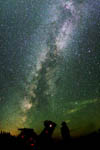 Under
the Milky Way: The supreme time@2006
Sep 20
Under
the Milky Way: The supreme time@2006
Sep 20
After some 4 hours sleep in my vehicle, I
got up at 2am. Wonderful sky! I could observe M33 by my naked eyes with
direct
vision. I could even observe its shape. M31 was about to immerse into
the Milky
Way! I wondered if the Milky Way was so wide.
After enjoying some deep sky objects I
began to comet seeking at 2:35am but unexpectedly, it was cloudy again
in 20
minutes. After that I cloud comet hunt only additional 20 minutes. Even
so, I
did do my best; I searched southeast, where Kreutz Sungrazers would
appear.
Sat Sep 2
Wonderful sky
with high transparency urged me to drive to the highland observing
site. After one hour drive I arrived at a pasture at an altitude of 850
m. The sky looked awful with so many stars! The Milky Way flows
as the same way from the ancient times and people must have had a
feeling of awe-inspiring like me. This must be the
best condition this year. One hour drive was rewarded.
I began to
enjoy star watching before comet hunting at 0:30am. Many stars resolved
in the globular clusters M2 and M15, the supernova remnants
NGC6992-6995 (Veil Nebula) and NGC6960 were impressive with complex
structures using OIII and UHC filters, and at least three dark lanes
were apparent in M31 with direct vision. NGC7293, the Helix nebula,
could be detected by 5 cm finder.
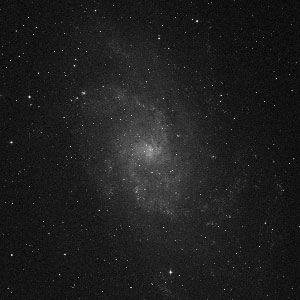
M33
The Digitized
Sky Survey copyright © 1994
However, the
highlight was five spiral arms in M33 that could be observed with
direct vision! I recognized some HII regions in the galaxy: NGC 604 is
the brightest among them and could be seen easily. I tried to observe
M33 with naked eyes, and I could see it with averted vision. The
naked eye limiting magnitude was only 6.1, unexpectedly, in spite of my
good first impression for the sky.
Some one dozen
years ago, I could observe M33 by naked eyes with direct vision at my
parentsf house where light pollution was much more serious than that of
my residence at present. Light pollution became much more serious in
this decade or so. How disappointing! Even so, I was impressed by the
starry sky at the site. I have to cont my blessing because I could
enjoy observing the deep sky objects and comet hunting around my town.
After enjoying
the deep sky objects I comet hunted for 2 hours and half. I took some
breaks during the comet searching session. One reason was that I could
not concentrate on long hunting hours and another was unstable weather:
cloud covered entire sky from time to time. At the time of twilight
zodiacal light went up from the horizon, extended to Castor and Pollux
and crossed the Milky Way.
Sun Aug 27
I did not intend to get up this predawn,
but fortunately I did before 3a.m. due to a bike noise of a newspaper
carrier.
About 40% of the sky was covered with cloud; however, the sky condition
was
good enough to do comet hunting.
It has been cloudy through the night in
spite of clear sky during daytime in the latter half of this month. In
Friday
predawn I went out and assembled 46 cm telescope under the excellent
sky condition;
clouds spread all the sky when I finished assembling the telescope
until the beginning
of the twilight. It was momentary fine weather. Yesterday, I woke up at
4a.m.,
and it was cloudy as the weather forecast predicted. Today, it was
exceptional.
OK, went out and began!
However, it was less than one hour until
the beginning of the twilight and it was time consuming to assemble 46
cm comet
seeker; it takes some 30 minute to stand by. This time, I decided to
use 20 cm
telescope. To initialize the digital setting circles I trained the
scope on
Capella, Alpha Aur, and felt if it was actually Capella because it
looked much
darker in the field than usual. Soon I recognized that I used 20 cm
instead of
46 cm and understood the reason.
NGC1907, open cluster near M38, looked like
a comet with this instrument, but it is resolved using 46 cm that I
routinely
employ. 20 cm is comfortable to operate and is easy to assemble, but
the light
gathering power and the resolution are much less than those of 46 cm. I
prefer
to use the larger one if I can afford, since I can detect darker comet
that
many hunters miss.
Tue Aug 8
The
saying of e10 days after the end of the
rainy seasonf just fits this summer. It means that clear sky continues
for 10
days from the termination of the rainy season that was July 30 this
year. I
conducted comet hunting 6 times this month so far.
This predawn the
transparency was pretty
good, though the time between moonset and the beginning of the twilight
was
only 30 minutes. I began to sweep the southeastern sky at 2:30 am, when
the
moon was still at the western sky.
The
field of the telescope was rather
bright with low contrast due to the moon light, and it made difficult
to split
faint double or a multiple star that looked like a comet. I sometimes
stopped
the motion of the comet seeker and peered into the comet-like object or
must
change eyepiece to confirm if it was actually the double or the
multiple star
with higher magnification. For this purpose I use Naglar 12 mm with
170x.
The
field became darker and the contrast
was getting higher as the moon declined. It was easy to split faint
multiple
stars after the moonset because of dark background.
I
caught several galaxies in Cetus and Eridanus. I wonder how far these
galaxies were, and if dinosaurs were alive when the light I saw left
the
galaxies. One of the galaxies I observed was M77 that is 65 million
light
years far (The Night Sky Observerfs Guide, Willmann-Bell Inc.);
this light left for us just when dinosaurs became extinct.
Stars
in our galaxies, quite a few of which
went through in the field, are much closer; they are hundreds of or
thousands
of light years. I felt 3D effect by imagining the distance of those
objects.
Again,
the S/N (signal and noise) ratio
became low. This time it occurred not by the moonlight but by the
twilight. It
is full moon tomorrow, but I could enjoy comet hunting this predawn
since the
moon was at low right declination and it set early.
Sun July 30-Mon
July 31
The rainy season has finished today, July
30. It was clear in daytime but when I arrived at the observing site at
8 pm, cloud
covered the most part of the sky. Around 9 pm a cloud gap opened and it
began
to spread. I tried to observed 177P Barnard that approaches us after
117 years
since last return.
First, I trained my 46 cm comet seeker on
the comet with the digital setting circles but its accuracy was not
good near
the zenith and I could not spot it in the telescope field. Then, I
referred to
the finding chart that I printed out in my house using MegaStar Ver.5.
However,
I could not identify the asterism in the 5 cm finder scope. I tried
again and
again, but I could not. I spend more than 10 minutes for it without
knowing the
reason. Something was wrong. At the next moment, the field became gray
due to
cloud cover. What a nightmare! I had been looking forward to observing
this
comet!
I
waited for the next chance for half hour and
luckily again a cloud gap began to grow. It extended to Hercules where
177P was.
The asterism in the finder scope was different from the printed chart
again
however, and I doubted the chart. I opened the Uranometria 2000; I
found that
the asterism on the Uranomertia was right and the MegaStar 5sf was
wrong!
Anyway, I could train the telescope on the comet using Uranometria 2000
and
conducted the observation.
It has the magnitude of 8.7 with 9f
diameter and DC 2. It was very large and defused object. I guess the
surface
brightness was 12 th magnitude, and it was a rather difficult object
with 46 cm
telescope. M. Tsumura reported he could observe 117P with 4.5 cm
binocular.
Defused comet like this is easily detected by a small binocular or
telescope
but is difficult for a large aperture.
Letfs get back to the star chart. Why was
MegaStar 5 wrong? It turned out that 6 th magnitude star, Her 56, Tycho
ID T
2063:1212:1, was superimposed on the printed name eBarnardf, which I
could not
distinguish at the site with a red LED light.
The field activity has unexpected
difficulty like this at all times.
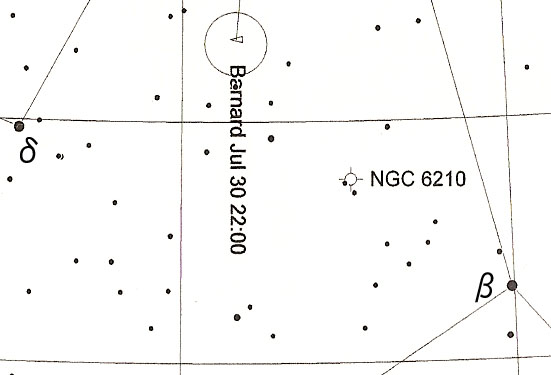
The
first character eaf in e Barnardf is
superimposed on Her 56, 6th magnitude star.
A circle
indicates the field of 46 cm comet
seeker with 68x, 1.3 degrees.
I
slept in my car and got up before 2 am.
As the forecast predicted, the amount of cloud was less. I began to
comet hunt
from the southeast where there was no cloud. I could catch a few 12th
magnitude galaxies but could not 73P Schwassmann-Wachmann.
I was satisfied
with an hour and 20 minutes
comet hunting session since June 13.
Fri
Jul 14
There was a storm at the night of June 30,
and the total rainfall amount in June did not record its minimum for
the 90
years as I described on June 29.
This evening the sky was fine with a small
amount of cloud. Before leaving my office I tried to check the time of
the end
of the twilight and the moon rise. I thought that there must be enough
dark sky
period to do comet hunting this dusk, since I knew it was the full moon
a few
days ago. OK, the Astronomical Pocketbook read there was more than one
hour!
After
I got home and finished supper I left home for the upland to comet
hunt. On my
way to the observing site the coverage of the cloud began to rise and I
noticed
the top of some mountains were in the clouds.
Anyway, I arrived at the site and assembled
my 18 inch telescope. What a wonderful activity to assembling the
telescope
hoping for the starry night that I could enjoy in half an hour! I
especially
felt so, because I had not swept the sky since June 13 due to nasty
weather.
When I completed the assembling, cloud
spread all over the sky; all the stars I could see in the sky through
the cloud
were Arcturus and Jupiter. In a little while those two stars
disappeared. I spread
the plastic sheet on the ground and lay down on it to wait for the
emergence of
the cloud gap. Warmness of the ground was comfortable but no stars
appeared in
the sky. I disassembled the telescope and left the site around 9 pm
after all.
Usually, the weather condition in the rainy
season is worse than in winter when we have a few meters of snow here
on the
Japan Sea side; I could comet hunt at least once per month in midwinter.
Wed June 29
The rainfall
amount this month is the
smallest
since the beginning of the observation in
1917 in my workplace,
Tohkamachi Experimental Station,
if no
rainfall would be observed tomorrow. Even so, there were few nights
that the
comet hunting was possible: I could do it only twice this month. The
sky is
covered with thin cloud tonight also, though the forecast predicted
clear sky.
It was exciting that LINEAR spotted P/1889
M1 (Barnard 2) after 117 years' separation one week ago. How wonderful
it is
the comet was discovered unexpectedly after over one century of the
first
discovery. If the discovery had been made by an armature,
especially
visually, the story would have been much cooler!
Greater dream for most comet hunters are to
discover a periodic comet or a great comet. There still must be such
chances
for every hunter.
I
am inpatient for the clear sky.
Sun
Jun 11
I
could sit back and relax in the bed at
predawn on this week end, because it is full moon today.
This
month it has been depressing weather
and I could comet hunt only once so far, on last Sunday June 4, in
spite of
optimistic forecast as the end of last month.
I
wonder if the amount of cloud is boosted
by the Global Warming, and it gives rise to the number of cloudy days.
I think no
meteorologists can prove whether this scenario is correct or not due to
lack of
data and incompleteness of the modeling. Anyway, reduction in the
number of clear
days is disappointing.
Another
bad news for me is that the new
solar observation satellite will be launched next month: STEREO (Solar
TErrestrial RElations Observatory)
http://stereo.gsfc.nasa.gov/mission/mission.shtml
According
to Karl Battams, via Hirohisa
Sato OAA-comet mailing list, coronagraphs are equipped in the satellite
and images
will usually be taken as +90/0/-90 -degree triplets. The instruments
would be a
new threat of comet hunters, especially low altitude hunting near the
sun.
You
do not know what will happen until the operation
begins. However, it is yourself who judge if the new satellite really
threats you
or not.
Winners
never quit, and quitters never win.
-Ted
Turner (U.S. broadcaster
and sports executive, 1938- )
Sat May 27
The forecast said clear sky prevails at this predawn and I got up at 1
am and again at 2 am. It was cloudy, however. Ironically, the sky is
very clear this morning; probably since the sunrise.
Yesterdayfs predawn, the circumstances was similar: I went out of the
bed at 1 am but no stars were twinkling on the sky, although the
prediction claimed it would be fine.
At the predawn of Thursday also, the situation resembled that of today
but it was better: the forecast predicted clear sky and I got up at 1
am but in
vain. I looked at the sky again at 2:18 am and it was clear! The
twilight began at 2:43 am and there was no time to assemble my 18 inch
telescope and to move to the usual observing site where the sky
condition is superior. Instead,
I assembled my 8 inch reflector in front of my residence. I could
search
the lower part of the eastern sky with 31x for 40 minutes.
The forecast in this season is difficult since a slight motion of the
Rainy Season Front changes the weather drastically, though the mesh-weather forecast
system in
our country is one of the best in the world, I believe.
The Japan Meteorological Agency (JMA) made a public announcement
yesterday that the southern part of the Kyusyu Island, the southwestern
Japanese Island where comet hunters Utsunomiya and Kudo live, entered
the Rainy Season. Hyakutake also lived this Island. I guess that the
area I live would do in a couple of weeks but Japanese Rainy Season
does not necessarily bring constant rainfall; usually it includes some
clear days. I have to watch out for the weather not
to lose the chance.
Wed May 10
Moon set at 2:54am and the twilight began at 3:01am. I did not have
enough time to do three kinds of activity: taking photos, visual
observation, and comet hunting.
At 2:30am I had assembled both 18 inch telescope for comet hunting and
an equatorial mount for taking some photos of 73P Schwassmann-Wachmann
fragments. Fragment C approached Beta Cygni, Albireo and fragment B
passed near Alpha Lyrae, Vega. As a result, I failed to fragment C due
to out of focus.
I am trying astrophotography not only just for fun but for practice:
when I spot a new comet, I want to confirm it by photos.
Fragment B that busted was easily visible by naked eye and looked over
one magnitude brighter than M13: It must be magnitude of 4th to 5th and
also looks brighter than
Epsilon
or Zeta Lyrae in the photo.@However, visual observation I made last
evening by 5 cm binocular resulted in magnitude of 6.1 and rough
estimation
at this predawn was almost the same.
Many observers estimated it as 6th magnitude using binoculars. This
sort of discrepancy, including the differences in magnitude estimation
between visual observation and CCD, has been pointed out by many comet
observers
but the exact cause is unknown.
I could spend 35 minutes for comet hunting from 3:10am.
Thu May 4
I have arrived at the observing site at mid night, because I tried to
astrophotography with guiding for the first time since my boyhood; I
took the last one more than 25 years ago. Off course, tonight I aimed
at 73P
Schwassmann-Wachmann Component C and B.
The results were not satisfactorily due to poor alignment of polar axis
telescope (not polar alignment itself), and lack of focusing skills for
digital camera lens.
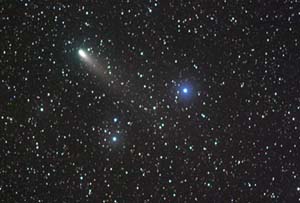
73P Schwassmann-Wachmann
component C, 2006 May
3.7073UT
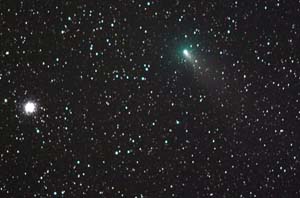
73P Schwassmann-Wachmann
component B and
M13(left),
2006 May 3.6784UT
Common data: Canon 20Da,
EF200mm F2.8 (F2.8), three minutes exposure, ISO 800, Takahashi Sky
Port
portable equatorial mount. Images were cropped.
After taking photos, I observed
a series of this comet.
I could barely observe 73P Schwassmann-Wachmann C with naked eye, but
could not 73P-B. 73P G was very diffuse, though 13th magnitude, and
just the limit for my instrument@(18@inch). I have to turn the azimuth
axis
of my telescope 180 degrees for a short time during the observation of
this comet, since it had just passed the meridian near the zenith! It
was
hard work and for me this was the first experience. I also tried 73P R
but
I could not.
After observation, I began to comet hunting at 2am and finished at
3:30am. Today is a national holiday and I can have enough time to sleep
after dawn.
Thu Apr 20
Whizzing wind woke me up at 1:50am. The sky was clear. I hesitated
to comet hunt with 18 inch telescope because of the strong wind.
However, it seemed to be weaker with time and I decided to assemble my
18 inch.
The sky was bright due to last quarter moon and the southern wind was
dry and warm. I started search from Gamma Cygni toward north.
Scintillation was extremely bad and it must be caused by the strong
wind in the upper air. The star images were distorted and looked fleshy
that made this comet hunting session uncomfortable: each star looked
like a comet.
Suddenly, at a quarter past 3am, scintillation became much better.
How easy and cool to search! The sky area I covered this predawn
included
the position of C/2006 A1 Poimanski that must be reduced to 10th
magnitude, but I could not catch it due to twilight and moon light.
Fri Apr 13
Kazimeras Cernis, a Lithuanian comet hunter, sent me a copy of book
written by an American comet hunter Don Machholz entitled gA decade of
comets: A study of the 33 comets discovered by amateur astronomers
between
1975 and 1984h. I exchange email with him every now and then but
it
came unexpectedly.
It consists of 111 pages, including description on the time,
magnitudes, positions, the statistics of discovery and orbital
elements. Tsutomu Seki had ever written similar booklets in Japanese,
though some Sekifs books features spiritual point of view; they are
fable rather than scientific reports. I guess his literature was not
known in foreign countries, unfortunately. Those kinds of publications
often feed and encourage comet hunters. Actually, I was one of them. If
it were not for Sekifs book, the number of Japanese comet hunter would
be much less.

A copy of Machholzfs book.
Sat Mar 25
I was ready to comet hunt at 2:45am but before it, I observed 73P
Schwassmann-Wachmann component B that was darker than the main
component C. The result is cited here. I could not notice the
component C at 68x and increased magnification up to 170x. Then, it was
apparent at a first glance. After brightness measurement, I changed
magnification to 68x again. Now, the component B was easy to observe
with 68x. To find a known deep sky object or a comet is one thing; to
discover unknown one is another.
Howt graceful@the component C was! The tail was 6 arc minutes in
length that was the same with the component B. But I must make it a
snap. I just watched it and soon after that began to comet search.
It took 25 minutes to observe 73P that was long time for a comet
hunter at predawn. I always hesitate whether I really@should observe
comets
or not, especially when I conduct brightness measurements because it is
time consuming work. However, regardless of doing brightness
measurement
or not, I never regret to observe a graceful comet that gives me an
impression of subtle and profound.
Sat Mar 18- Sun Mar 19
I attended the
36th Annual Comet Conference in Nishiharima
Astronomical Observatory, Western Japan, where 2 m (79 inch)
telescope, Nayuta, had the first light last year. This is the largest
telescope at home.
The Conference began in Saturday afternoon and closed at Sunday
noon. There were 44 attendees including both professional and amateur
cometary astronomers. The Conference consisted of 8 oral presentations,
4 sectional meetings and 73P Schwassmann-Wachmann session.

The opening statement by the chairperson of the Annual Comet Conference
management committee, Jun-ichi Watanabe of National Astronomical
Observatory Japan. Far left: the chairperson of Local Organizing
committee, Atsushi Mori of the Nishiharima Astronomical Observatory.
Unexpectedly, I was the only
comet discoverer among the attendees and was assigned to the chairman
of the sectional meeting on the comet hunting, in which 11 persons
attended. Six out of 11 attendees including me are active comet
hunters. On top
of those six hunters, one is planning to start comet searching and
making
a comet seeker, and another may resume hunting.
Two hunters are searching comets with DSLR (Digital Single Lens
Reflex) camera or CCD and others are visual comet hunters. There are
two Fujinon 15 cm binocular users, one Miyauchi 14 cm and Nikon 12 cm
binocular user, respectively. Others are reflector users but some use
both a binocular and a reflector.
For most hunters light pollution is a serious problem and they make
much effort to compensate for it; one said that he drove two
hours to
the observing site. Another remarked that he had supper and took a bath
and
then drove to the observing site to sleep in his car and got up at
predawn. After his comet hunting session, he heads for his office to
work!
Photographical hunters, especially CCD users have an advantage that
they can comet hunt under moderate light polluted conditions.
Yukio Sakurai who has discovered many novas shifted from a film
camera to a DSLR. He said that it is easy to take photos with DSLR and
he took a lot of images but it is time consuming to check all the
images.
Most of the comet hunters without discovery are unknown and you
do not know how many hunters in this country. Some people say there are
about one hundred active comet hunters in Japan, and I think it
is
reasonable judging from the number of hunters attended this Conference.
The next yearfs Conference is held in Niigata Prefecture, and I
was assigned to the chairperson.
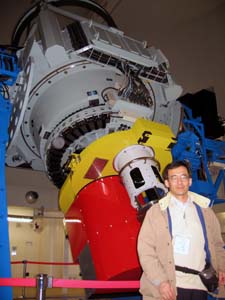
2 m telescope, Nayuta with me
This telescope is gphoto visualh and we could observed Moon, Jupiter
and 73P Schwassmann-Wachmann through thin cloud.
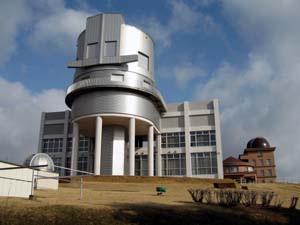
Domes of 2 m telescope
Nayuta, and 60 cm reflector (far right).
Sun Mar 5
It is bright! At last I could observe C/2006 A1 Pojmanski at this
predawn.
Yesterday, I got up at 2:30am and 3am but was clouded out. Then, the
clear sky spread after sunrise yesterday and has continued since
then.
Today, before comet hunting I observed 73P/Schwassmann-Wachamann 3 and
P/2004 VR8 LONEOS. 73P was 12th magnitude and the tail was apparent
with 18 inch 68x, while VR8 was only 14th magnitude and at a first
glance with 68x I was not sure if the image I focus on was actually the
comet. I confirmed it with 157x.
Seiichi Yoshida observed both 73P-C/Schwassmann-Wachmann 3 as magnitude
of 12.3 and 73P-B/Schwassmann-Wachmann 3 as magnitude of 14.4 but what
I observed was 73P-C. I had not prepared the finding chart of 73P-B.
OK, I started comet searching session at 3:30am but there was thin
cloud at the low altitude and the transparency was not very good. The
rating was 3/5 when 5 is perfect. My telescope was trained at some 10
degrees south of Altair and I swept the sky vertically so that I could
catch C/2006 A1 during the session. After detecting NGC6781, no comets
like
objects were observed after a while. Suddenly bright comet crossed the
field
with a straight tail!
The length of the tail, type I, was about 2 degrees and there was the
type II tail at the position angle of a few tens of degrees clockwise
from the type I tail. The type II tail was very short and looked like a
part of the coma that was ejected. I could also recognize the type I
tail
by a 8x50mm binocular.
After I enjoyed C/2006 A1 cloud in the eastern sky become thick and I
took 10 minutes break. I found there was cloud gap at Soc and swept
there. I completed the session at 5:20am.
Sat Feb 25
Impressive predawn!
The first half of todayfs comet hunting session I caught one dozen of
globular clusters in Scorpion and Ophiuchus, and the latter half I
enjoyed splendid star field in the Summer Milky Way in Cygnus.
I had set an alarm clock at 3am, two hours before the beginning of the
twilight, but I wake up at 2:25am. I drove to the usual observing site
where snow depth reduced to acceptable level. Just after one hour of
getting out of bed, I completed assembling my 18 inch telescope and
began
to search from M4, Scorpion. A lot of globular clusters that I met
welcomed
me for a long absence.
A few minutes after 4am, the light in a ski field had turned on that
caused serious light pollution in the south-eastern sky. Skiers
from Tokyo Area come to ski to this area at predawn.
I trained my telescope to the north-east and continued to search: the
Summer Milky Way in Cygnus touched me, too. Venus and the crescent Moon
rose and some time after the twilight began, I tried to observe
C/2006 A1 Pojmanski. However, the mountain near the horizon intercepted
the comet. Instead, I enjoyed Jupiter with a binoviewer and was also
impressive
like all the objects I observed this predawn! Apparently, observing by
two eyes reveals more details of Jupiter than by a single eye.
Fri Feb 10
Temperature was -9 degrees in Celsius. I began to comet search at 4:40
am, 20 minutes before the moon set and 30 minutes before the beginning
of the twilight. The summer constellations rose already in the
eastern sky.
I could comet hunt only once last month due to tight schedule, heavy
workload and snowy weather. On January 30 the sky condition for comet
searching must be excellent but I was in Nagoya area@to give scientific
presentation as a forest hydrologist. Since last comet hunting session
I had gotten up at the predawn a few times expecting clear sky, but in
vain.
That blank makes todayfs hunting session impressive, even though some
globular clusters I saw in Ophiuchus was not well resolved and stars in
the star ground in Sagittarius never looked pinpoint image because of
low altitude and poor scintillation.
As twilight proceeded the Summer Triangle rose in the northeast and I
completed the hunting session after Venus crossed the field.
C/2006 A1 becomes bright in the Southern Hemisphere. In my opinion and
I believe most agree with me, the naming of C/2006 A1 gPojmanskih is
inappropriate in reference to the discovery story. It should be
named ASAS (The All Sky Automated Survey).
Thu Jan 12
The Disaster Relief Act was invoked in my city and surrounding area
about a week ago. At the elementary school next to my office Japanese
Army (formally called the Self-Defense Force) removed snow cornice
on the roof. I thank them for their activity again: they came to my
city
about a year ago for the rescue activity of the Mid Niigata earthquake
in 2004.
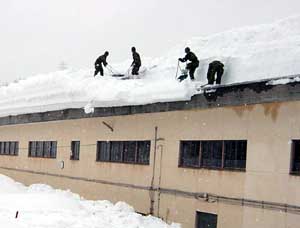
Tue Jan 10
Yesterday, clear sky spread and luckily, it lasted until this morning!
Off course, this is my first comet hunting session this year.
Temperature: -8 degrees Celsius. I decided to comet search in front of
my house on the snow where a snowplow pushes snow out to a paddy
field.
It took a lot of time to assemble my telescope and to prepare hunting
under such low temperature on snow. In addition to that, digital
setting circles did not work well; I tried to fix stars twice by aiming
at Spica and Polaris but indicator showed error messages. I wandered if
I got back my house and replace the digital setting circles with
extra one. At the next moment, I found Vega at low latitude and tried
to do again by combining Vega with Spica. This time it was OK! What a
relief!
I began to comet hunt at 4:20 a.m., one hour after I got up. After a
while, dew, caused by my breathing, condensed on the eyepiece and I was
forced to wipe it. Then, I powered the heater up than usual and after
that it never occurred: Kendrick
Dew Remover System is equipped on the flip side of the secondary
mirror, eyepiece of the 2 inch finder and the eyepiece of the18 inch
telescope.
When the eastern sky got brighter, I noticed the whole telescope looked
white because of frost. I could enjoy one and half hour hunting
capturing a dozen of deep sky objects.
Sun Jan 8
I went to usual observing site today not for comet hunting but for
check the sky visibility (Photo 1). You see a crash barrier rope on the
left of my car, which I dig out with a shovel. In normal winter I can
observe near the horizon from this hill slope site. Now snow depth is
3.5 m (11.7 feet) and it hides up to 20 degrees sky from the horizon. I
do not want to comet hunt at this site now.
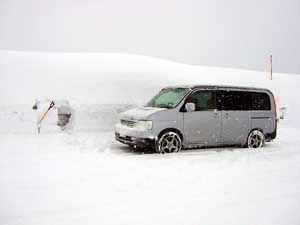
Photo 1
Observing site with 3.5 m (11.7 feet) snow.
Cold wave still prevails nationwide and a record snowfall is observed
in a lot of observing points. The chance of comet hunting seems scant
this winter, especially here in Japan Sea side.
Snow depth in my city, Tohkamachi (or Tokamachi), has reached 3 m
(10 feet, Photo 2-4) but this value itself is not surprising: The
highest one was 425 cm (14.17 feet) that was observed in 1945. The
problem is that it is too early and that it must increase from
now on.
The snow depth chart from 1917 to 2005 in Tohkamachi (observed at my
workplace) is available here
(pdf file) and the latest snow chart is here (lower
right).
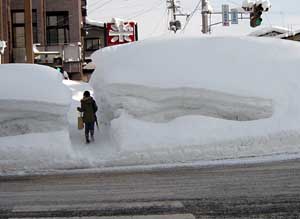
Photo 2
A girl has crossed the road and eentersf a sidewalk. If it were not for
snow, it would have been mere sidewalk; however,
she has to enter there due to snow. Taken on Jan 7.
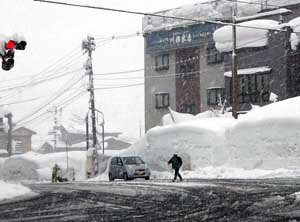
Photo 3
A man is walking on a pedestrian crossing. The snow wall in this photo
is the same with Photo 2 but it became higher. Taken on Jan 8.
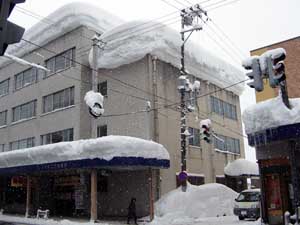
Photo 4
A snow cornice on the building developed and seemed dangerous. Snow on
the shopping arcade and a city house was plowed many times but a
ferro-concrete building does not. Now snow weight is 800 kg/m2 that is
approaching to the structural limit for the ferro-concrete building,
990 kg/m2.
Top of this page
 Under
the Milky Way: The supreme time@2006
Sep 20
Under
the Milky Way: The supreme time@2006
Sep 20













